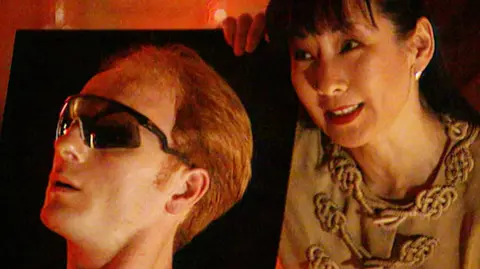 BBC
BBCIn 1995, the BBC’s Tomorrow’s World programme determined to foretell what the world would seem like 30 years later, in 2025.
The present, which is not broadcast, featured one of the crucial well-known scientists of the age, Prof Stephen Hawking, who predicted: “By 2025 we are able to anticipate huge modifications.”
The programme crew agreed, suggesting a raft of world-shaking improvements from hologram surgical procedure to house junk gel.
So, with the assistance of some specialists – and the advantage of three many years of hindsight – let’s check out how a lot of at the moment’s world that Tomorrow’s World efficiently anticipated.
The ‘Our on-line world Riots’ of 2005
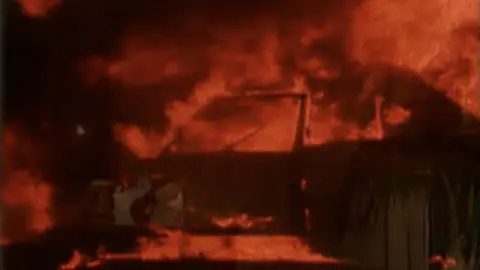
In 1995, the world broad internet was actually taking off – a growth Tomorrow’s World thought would convey future bother.
They predicted “enterprise barons” and banks would take management of the web by 2000, establishing a “supernet” which they restricted entry to.
That, in flip, would immediate hacks, viruses and even riots.
Verdict – The web has remained – largely – open, and there have been no riots however there’s little doubt the actions of hackers have brought about distress for many individuals.
One factor the programme did not predict was the position of the nation state hackers like North Korea, expertly informed within the BBC’s Lazarus Heist podcast.
Cybersecurity is vastly necessary for governments and firms, and people who find themselves suspicious of banks have championed cryptocurrencies like Bitcoin.
Asteroid mining and house junk gel
The programme speculated house mining would turn out to be a profitable business, with corporations excavating asteroids close to Earth for valuable metals.
The present additionally steered house junk would turn out to be such an issue it will not be protected for astronauts. The reply – a huge foam gel to decelerate particles.
Verdict – Nicely, there isn’t a tremendous foam gel and the issue of house junk is an acute one. There may be additionally no house mining business – however that would change.
Futurist Tom Cheesewright is an optimist about mining past our planet.
“The potential riches are unfathomable and the expertise is totally inside our grasp,” he mentioned.
The tremendous surgeons and their robots
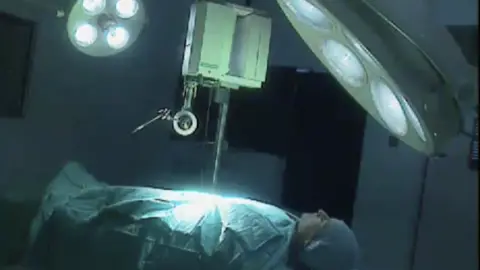
Tomorrow’s World predicted by 2004, a regulation could be handed for all UK hospitals to publish a league desk of surgeon success charges. The highest surgeons would turn out to be so fashionable, and so properly paid, it will make no sense for them to journey to sufferers.
As a substitute, affected person holograms could be despatched to them and the surgeon would function utilizing “spacial gloves”. On the affected person’s finish, a robotic would completely mimic the actions of the surgeon.
Verdict – They did not get it precisely proper however robots are helping with surgeries.
A sensible speaker with a floating head
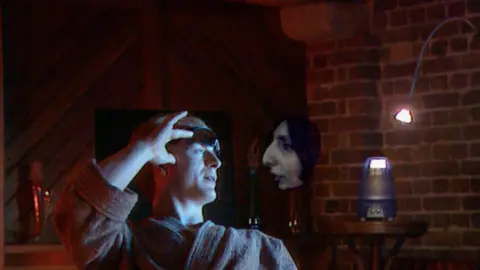
The programme featured a person of the long run (carrying a fetching VR headset), his spouse and a younger lady in what seems to be modern-day London.
In a single part, the floating head of a lady comes out of a “good speaker” to inform the person it has been a yr since his vacation to “Indo Disney.” She encourages him to take one other vacation through a “shuttle to Bangalore” – which might solely take 40 minutes.
Verdict – Extremely-fast journey feels as distant as ever, however holograms, good audio system and VR headsets have gotten ever extra prevalent.
Banking utilizing a microchip in your arm
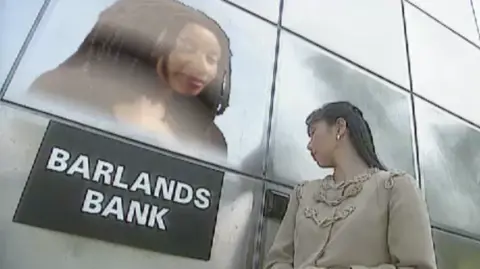
Elsewhere within the programme, we got a imaginative and prescient of the way forward for banking.
It featured a lady going to a financial institution, complaining there have been no people, after which withdrawing 100 “Euro marks.” The financial institution offers her the cash after scanning a chip in her arm.
Verdict – Banking has certainly turn out to be increasingly automated. And although paying through microchips contained in the human physique is a reality, different applied sciences – primarily fingerprint and face scanning – are rather more broadly used.
Reminiscences from the presenters
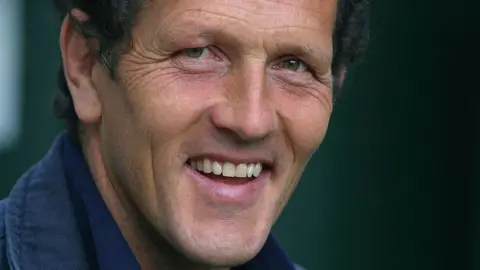 Getty Photographs
Getty PhotographsGardeners’ World star Monty Don was one of many presenters on that Tomorrow’s World programme 30 years in the past. His section predicted an enormous restoration of British woodlands because of genetic engineering and multi-storey agri amenities, resulting in the return of animals together with the brown bear.
Reflecting on it now, he informed BBC Information that his a part of the programme was “utopian” and “naive”.
Wanting in direction of the subsequent 30 years, he’s happy the present technology of younger persons are “rather more delicate to local weather change” and thinks individuals shall be rising extra of their very own meals by 2055.
He added: “Tomorrow’s World was by definition geared in direction of the best way that mankind may change and enhance the world, whereas what we’ve actually learnt since then is that mankind has a behavior of constructing issues worse, notably environmentally, and we’ve to work with nature quite than attempt modify and management it.”
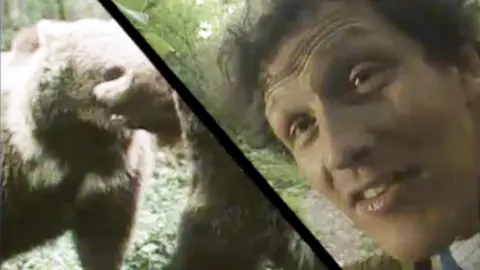
Vivienne Parry was one other presenter on the prediction present, and fronted a piece about medication.
She fondly remembers filming it – and the quite restricted visible results of the day. “I needed to keep completely nonetheless. I had a set of glasses on with a little bit digital camera hooked up. They had been caught on my face through a giant blob of black sticky stuff.
“It was this fantastically sizzling day, and this black stuff began to leak down my face and I could not transfer. Somebody from make-up got here together with an extended cane with cotton wool on the tip to get it off.”
Vivienne has been concerned with Genomics England since 2013, and highlights that among the predictions from the 1995 Tomorrow’s World about genomic sequencing have come true, as she works on a research study to help diagnose and treat genetic conditions.
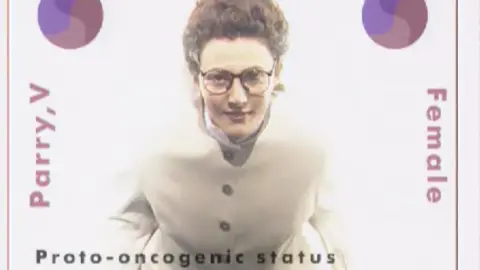
So what may the world seem like in 2055?
Futurist Tracey Follows thought the 1995 programme obtained a variety of huge concepts proper, however missed two of the most important themes of the final 30 years – the unfold of massive tech and social media.
By 2055, she thinks many individuals shall be “cognitively related” – a hive thoughts of people and expertise through servers, which can assist in the sharing of concepts.
“Brainstorming will actually be brainstorming, the place you’ll be able to share concepts by pondering them.”
Tom Cheesewright thinks two of probably the most thrilling prospects for the subsequent 30 years shall be supplies science and bioengineering.
In supplies, the creation of gadgets which might be even stronger, lighter and thinner may change the world, whereas bioengineering – married with tight regulation – has the ability to rework medication and sort out “among the largest challenges humanity faces – decarbonisation, clear water, meals”.
So what do you assume the world will seem like in 30 years?
No matter your solutions, it will be smart to hearken to what Prof Hawking mentioned to Tomorrow’s World three many years in the past.
“A few of these modifications are very thrilling, and a few are alarming. The one factor that we could be positive of is that it is going to be very totally different, and doubtless not what we anticipate.”



